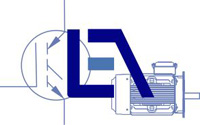Schulz
Dr.-Ing. Martin Schulz
"Ein Beitrag zur Nutzung regenerativer Energie in Kleinstkraftwerken im Inselbetrieb" (2005)
The present dissertation deals with several aspects related to the electrification of remote areas. Being restricted to plants with electromechanical energy conversion, solar cells are not part of the research done. The work describes the prime movers to be utilized: the water wheel and the windmill. An analytic approach to describe the windmill is presented and necessary to understand the basic physical equations. As there is no mathematical way to describe the water wheel, measurements taken from a model build by the Research Center for Water and Environmental Engineering fwu provide the necessary characteristics of the water wheel. The watercourse in the fwu laboratories was used to measure the torque to speed characteristic of a triangular-segment cell-wheel under well defined conditions. These measurements are especially worth to be mentioned as almost no information regarding the water wheel characteristics is available in the literature.
The description of the basics of the two prime movers is followed by the presentation of three different generator types. Special attention is paid to the self excitation process of the asynchronous machine, which is analytically examined in detail to create appropriate simulation models. The approach to describe the behavior of the machine in the rotor reference frame allows the consideration of the residual magnetism as a cause for the self excitation. The nonlinearities of the iron are also included in the model which leads to good consistency between measured and simulated results.
A further contribution of innovative technology is the introduction of the rotating armature machine with switchable stator windings. This particular generator allows a wide variation of speed and is therefore especially suitable for its utilization together with the windmill. From the large number of possible of power electronic topologies, three are of special interest and became part of the investigations. First, the ferroresonant transformer as a magnetic voltage stabilizing device is analyzed. The work contains a detailed analysis, how the magnetic nonlinearities lead to voltage stabilization. The second topology is the well known PWM-inverter as an indirect energy converter. The matrix converter, representing the family of direct converters is also considered as possible solution. Newly designed reverse blocking IGBT allow both, compact design and high efficiency of matrix converters as it was demonstrated in the work.
A closer look to all power electronics topologies and their particular properties and possible combination to the considered types of generators is done. Each of the systems is build as a laboratory prototype and its function is demonstrated. In the progress of the work, a laboratory setup was created, allowing emulating the prime mover to test the whole energy conversion systems without the need of a water course or a wind tunnel. The emulation in the laboratory set-up is based on the knowledge of torque to speed characteristic of the prime movers. With this setup, all considered systems were tested and their capability to achieve the goal set was validated. Furthermore a basic financial study was done to estimate the price for each of the systems studied. Though it does not consider the marketing aspects, it allows a statement regarding the cost of material for each of the solutions proposed.
